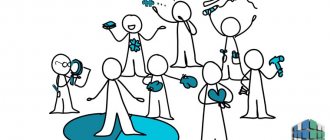Character (from the Greek charakter - seal, embossing, distinctive feature, sign, omen, peculiarity. The concept of “character” means the totality of individual mental properties that develop in activity and are manifested in methods of activity and forms of behavior typical for a given person.
Character is an individual combination of stable mental characteristics of a person that determine a typical way of behavior for a given subject in certain life conditions and circumstances.
Character is an established system of stable mental characteristics that express a person’s different attitudes towards reality and himself.
Character is a set of stable personality traits that determine a person’s attitude towards people and the work they do. Character is manifested in activity and communication (like temperament) and includes what gives a person’s behavior a specific, characteristic shade (hence the name “character”).
Character expresses the most typical essential features of a person, knowledge of which allows one to predict how a person will act in certain situations.
Character reveals dependence on worldview, beliefs and moral principles, revealing its socio-historical nature.
What is character?
Character is a system of relatively constant mental properties that determine the behavior of an individual and the main features of his interaction with the outside world. Character is formed and developed throughout life. It includes many personal qualities, patterns of behavior and habits that are formed under the influence of external and internal factors.
The term "character" is derived from the ancient Greek word χαρακτήρ (read as "character"), which is translated as "special mark", "distinctive feature" or "sign".
The character has two key features:
- character traits are stable if we take into account a short period of time, but they change with the accumulation of knowledge and life experience;
- character determines a person’s entire life, influencing most of his decisions, actions and statements.
The most typical personality traits are manifested in character. Thus, knowing well the character of a certain person, it is possible to predict his behavior in different situations and reaction to certain events with fairly high accuracy.
In psychology, an entire section is devoted to the study of character—characterology. She studies the essence of character and its types, as well as the processes of its formation and development.
Temperament and character accentuations
Accentuations are situations when one or another trait in a person’s character prevails over others - for example, a tendency to self-criticism, self-sacrifice, or pronounced negligence. Such a character imbalance is not recognized as a disorder in psychology, but it can create a lot of problems for a person and the people around him. It becomes difficult to communicate and work with him; at the same time, accentuation prevents a person from correctly assessing himself and deprives him of opportunities for harmonious development.
Accentuations do not depend on the type of temperament and can appear in both sociable sanguine people and closed melancholic people. Usually they do not dictate rules of behavior and do not appear constantly, but only from time to time, in connection with a specific situation or environment. As a rule, accentuations develop in adolescence and smooth out as a person grows older.
How is character revealed?
Since character is a combination of a large number of relatively constant properties of the psyche, its manifestations are present in every action in all spheres of life. These manifestations, as a rule, are represented by extreme degrees of certain forms of behavior. Let us consider the manifestations of character in different areas in more detail.
In relation to yourself it could be:
- modesty and arrogance;
- shyness and vanity;
- self-criticism and self-confidence.
In relation to others:
- isolation and sociability;
- the desire to dominate and the desire to be part of a team;
- trust and distrust;
- hostility and friendliness.
In relation to work:
- hard work and laziness;
- responsibility and irresponsibility;
- good faith and bad faith.
In relation to material assets:
- generosity and greed;
- thrift and extravagance;
- neatness and sloppiness.
The ancient Greek philosopher Heraclitus once said, “Character determines destiny.” And this is really so, because it manifests itself in every everyday little thing, in every serious or small decision and in every phrase spoken to a close or not so close person.
Character temperament test
There are several tests that help determine the type of temperament and predict a person’s character and behavior in the future. Most often, psychologists use such questionnaires.
- Eysenck Personality Questionnaire. It was compiled by the British psychologist Hans Eysenck in the middle of the last century, but not only has not lost its relevance, but also remains the most frequently used test in this area. It includes 57 questions, answering which a person indicates his characteristic principles of behavior in specific situations. It takes 10 minutes to fill out. When determining the result, they are guided by the extraversion and neuroticism scales.
- Belov's temperament formula. Includes four tables with yes or no questions. Depending on the total number of pluses (positive answers) in each of the tables, the dominant type of temperament can be determined.
- Strelyau questionnaire. Compiled by Polish psychologist Jan Strelyau to determine the characteristics of the nervous system of the subject: the tendency to excitation and inhibition. He developed his own system of temperaments, which differs from the generally accepted one, but allows one to determine whether a person is an extrovert or an introvert. The questionnaire contains 134 questions, you need to answer them “yes” or “no”.
pixabay.com/
How is character formed?
Erich Fromm wrote in one of his works: “The character of a child is a copy of the characters of his parents.” Thus, the main factors in character formation are genetic background and the personal influence of the child’s parents or guardians. In the future, the development of character is influenced by everyone with whom the person comes into contact: educators and classmates, friends and lovers, work colleagues and strangers with authority.
Throughout life, character is influenced by temperament, which determines a person’s reaction to current events (we will look at how temperament influences character below). Therefore, some people become sociable, responsible and decisive, while others lack these character traits.
Different character traits are formed at different periods of life:
- Primary features. This part of the character is formed in early childhood (usually from 2-3 to 7-9 years).
- Social traits. This part is formed mainly at school age - between 7 and 14 years. During this period, children learn the intricacies of social interaction through contact with relatives, classmates, friends and teachers.
- Strong-willed traits. The formation of will and discipline occurs between the ages of 14 and 18. In adolescence, a person is constantly faced with a choice between correct and desired actions, and is aware of the consequences and cost of decisions made.
- Basic features. This is an extensive group of character traits that form, develop and change throughout life. It includes curiosity, sociability, responsiveness, morality, the ability to compassion and other traits that determine a person’s interaction with society and the outside world.
By adulthood, character is usually formed and consolidated. After that, it continues to change, but much more slowly. This mainly occurs under the influence of factors such as:
- example from loved ones and simply significant people;
- other people's opinion, approval and condemnation;
- culture (literature, films and other works);
- moral standards, religion and ideology of society.
In recent years, the Internet has become one of the most important factors influencing the character of people of all age categories. On the Internet, people get acquainted with cultural works, watch videos and play games. But the main factor is still communication. Internet users get the opportunity to communicate with a large number of different people (including foreigners), participate in discussions, and join different communities.
It is believed that a modern person becomes a mature personality with a fully formed character around the age of 30. By this age, the basic character traits necessary to achieve professional success and start a family are consolidated. Of course, many people become successful and start families earlier. But at the age of 30, a person develops such fundamental traits as determination, discipline, responsibility and endurance.
Your psychologist. The work of a psychologist at school.
| Character |
| Capabilities |
| All pages |
Page 3 of 4
3.3 Character
Theoretical information
| Concept and structure of character. |
Character is a substructure of personality, which is formed by an individually unique set of stable personal characteristics, expresses its attitude to reality and determines the behavior typical for a given personality. Character is the prerequisite and result of a person’s actual behavior in specific life situations; by determining his behavior, he is formed in behavior (a consequence of the law of the unity of consciousness and activity) [Rubinshtein S.L., 2017]. Character, along with temperament, is one of the most significant forms of personality manifestation. If temperament determines the dynamic side of personality, then character determines its content. Character leaves its mark on all the actions, thoughts and feelings of a person, by which we judge personality traits. Not all of its features are part of the character, but only significant and stable ones. When they talk about character, they usually mean just such a set of properties and qualities of a person that leave a certain stamp on all its manifestations and actions. Character traits constitute those essential properties of a person that determine a particular way of behavior or way of life. The statics of character are determined by the type of nervous activity, and its dynamics are determined by the environment. Character is also understood as: - a system of stable motives and modes of behavior that form a behavioral type of personality - a measure of the balance of the internal and external worlds, the characteristics of an individual’s adaptation to the reality around him; - a clearly expressed definiteness of the typical behavior of each person. The character of the human personality is always multifaceted. It is determined by the totality of personality traits and qualities. All these personality traits, or qualities, can be divided into several groups, which reflect a person’s attitude to different aspects of life. Each group that forms symptom complexes includes positive and negative qualities: 1) a person’s attitude towards other people, the team, society (sociability, sensitivity and responsiveness, respect for other people, collectivism and the opposite traits - isolation, callousness, callousness, rudeness, contempt for people, individualism); 2) traits that show a person’s attitude to work, his business (hard work, a penchant for creativity, conscientiousness in work, a responsible attitude to work, initiative, perseverance and the opposite traits - laziness, a tendency to routine work, dishonesty, irresponsible attitude to work, passivity); 3) traits that show how a person relates to himself (self-esteem, correctly understood pride and the self-criticism associated with it, modesty and its opposite traits - conceit, sometimes turning into arrogance, vanity, arrogance, resentment, shyness, egocentrism as a tendency consider yourself and your experiences at the center of events; egoism is the tendency to care primarily about your own personal good); 4) traits that characterize a person’s attitude towards things (neatness or sloppiness, careful or careless handling of things). All personality traits or qualities are significant for activity and communication. For each specific individual, there are main character traits that determine the general direction of the entire complex of its manifestations, and secondary traits, which in some cases are determined by the main ones, and in others may contradict them. Thus, character traits do not exist in isolation, separately from each other, but are linked together, forming a more or less integral character structure. The structure of character is revealed in the natural relationship between its individual traits. For example, W. Sheldon, in the process of research, found that if a person shows a love for comfort, then he is likely to have a good appetite, friendliness, sociability, and a thirst for praise and approval. If a person is a coward, then he does not have the decisiveness and independence in decision-making that are characteristic of proactive people, since decision-making presupposes personal responsibility. Naturally combined character traits form an integral structure. An integral character is a character in which positive connections between traits predominate. However, in life there are often contradictory characters. Contradictory character (discordant) is a character in which there are traits that contradict each other and determine different forms of behavior in similar situations. Typologies of characters. Attempts to construct a typology of characters have been made repeatedly throughout the history of psychology. One of the most famous and early attempts was the one proposed at the beginning of the twentieth century by the German psychiatrist and psychologist E. Kretschmer. Somewhat later, a similar attempt was made by his American colleague W. Sheldon, and today by E. Fromm, K. Leongard, A.E. Lichko and a number of other scientists. All typologies of human characters were based on a number of general ideas. The main ones are the following: 1) a person’s character is formed quite early in ontogenesis and throughout the rest of his life manifests itself as more or less stable; 2) those combinations of personality traits that make up a person’s character are not random. They form clearly distinguishable types that make it possible to manifest and build a typology of characters; 3) most people, in accordance with this typology, can be divided into groups. Among the approaches, the most common are: 1. The somatic approach is based on the doctrine of temperaments, and combines physiological and somatic approaches in its fundamentals: the mental identity of people is determined either by the characteristics of physiological processes, or by the somatic type of structure of the body - the constitution of the body, or by a combination of other physical qualities, for example , gene chromosomes (the authors of the approach are Hippocrates, Galen, E. Kretschmer, W. Sheldon, C. Lombrazo). 2. The socio-psychological approach connects characters with the orientation of the individual and the interaction of the individual with society, while K. Jung identifies a number of psychosociotypes, i.e. innate mental structures that determine a specific type of information exchange between the individual and the environment. K. Jung identifies 2 bases for character typology: 1) the personality is directed outward or inward (extraversion - introversion); 2) mental functions (sensations, intuition, thinking, feelings). In accordance with these characteristics, 8 character types were identified: extroverted feeling, extraverted-intuitive, extraverted thinking, extroverted-emotive, introverted feeling, introverted-intuitive, introverted thinking, introverted-emotive. Social-psychological typologies of character include the typologies of A. Adler, K. Horney, E. Fromm. You can also distinguish types depending on the professional orientation of the individual. For example, such a typology of people is presented in the concept of E.A. Klimov: types of people who choose activities in the sphere of “man - man”, “man - technology”, “man - nature”, “man - sign system” or “man - artistic image”. The psychiatric approach has become widespread in the form of a typology of characters that connects character traits with accentuation - excessive expression of individual character traits and their combinations (K. Leongard, A.E. Lichko, etc.). Character accents. The concept of “accentuation” was first introduced by the German psychiatrist and psychologist Karl Leonhard. Accentuation is a disharmony in the development of character, which manifests itself in the excessive expression of its individual traits or connections, causing increased vulnerability of the individual to certain types of influences and complicating its adaptation in some specific situations. Accentuation is not a disease, not a pathology, not a psychopathy, but an extreme expression of the norm. This is a sharpening of any individual traits, which, under certain unfavorable conditions, can lead to pathology - psychopathy. The famous Soviet psychiatrist P.B. Gannushkin formulated three criteria for psychopathy [Gannushkin P.B., 1982]: 1. Stability over time - character can be considered pathological, that is, regarded as psychopathy if it is relatively stable over time (changes little throughout life). 2. Totality of character manifestation - with psychopathy, the same character traits are found in all spheres of a person’s life: in production activities, at home, in communication with friends and relatives. 3. Social maladaptation - a person constantly faces difficulties in life. Moreover, these difficulties are experienced either by himself or by the people around him. In the case of character accentuations, there may be none of the listed signs of psychopathy, or, at least, all three signs are never present at once.
| Types of character accentuations. |
Depending on the degree of severity, obvious and hidden (latent) accentuations are distinguished. Explicit accentuations appear relatively constantly; with hidden accentuations, sharpened character traits are not detected until the person finds himself in extreme conditions. Under these conditions, hidden accentuations become explicit. In extremely unfavorable conditions for the individual, accentuation of character can lead to pathological changes in personality - psychopathy. Based on this theory of character accentuation, different classifications have been created. The most famous classifications are those of K. Leonhard and A.E. Lichko. Classification of character accentuations (according to K. Leongard) [Leongard K., 2000]
Demonstrative type.
The main feature of a demonstrative personality is the need to make an impression, attract attention, and be in the center of events. This manifests itself in vain, often deliberate, behavior, in particular in such traits as self-praise, perception and presentation of oneself as the central character of any situation. Much of what such a person says about himself often turns out to be a figment of his imagination or a significantly embellished account of events.
Pedantic type.
External manifestations of this type are increased accuracy, desire for order, indecisiveness and caution. Before doing anything, such a person thinks long and carefully about everything. Behind external pedantry is a reluctance to make quick changes and an inability to make them, and a lack of desire to accept responsibility. These people love their usual work and are conscientious in everyday life.
Stuck type.
The stuck personality type is characterized by high stability of affect, duration of emotional response, and experiences. An insult to personal interests and dignity, as a rule, is not forgotten for a long time and is never forgiven just like that. In this regard, others often characterize representatives of this type as touchy, vindictive and vindictive people. The duration of the experience is often combined with fantasizing and hatching a plan for revenge on the offender.
Excitable type.
A feature of an excitable personality is pronounced impulsiveness of behavior. The manner of communication and behavior largely depends not on a rational understanding of one’s actions, but on an impulse, drive, instinct or uncontrollable urge. In the area of social interaction, representatives of this type are characterized by extremely low tolerance.
Hyperthymic type.
A noticeable feature of the hyperthymic personality type is the constant presence in an elevated mood, even in the absence of any external reasons for this. High mood is combined with high activity and thirst for activity. Hyperthyms are characterized by such qualities as sociability, increased talkativeness, and an optimistic outlook on life. Difficulties are often overcome without much difficulty.
Dysthymic type.
Dysthymic personality is the opposite of hyperthymic. Dysthymics tend to focus on the dark, sad aspects of life. This is manifested in everything: in behavior, in communication, and in the peculiarities of perception of life, events and other people (social-perceptual characteristics). Usually these people are serious by nature, they are not active.
Affectively labile type (cyclothymic type).
An important feature of the cyclothymic type is the alternation of hyperthymic and dysthymic states. Such changes are frequent and systematic. In the hyperthymic phase of cyclothymes, joyful events cause not only joyful emotions, but also a thirst for activity and increased activity. In the dysthymic phase, sad events cause them not only grief, but also a state of depression. This state is characterized by slowness of reactions, thinking, and emotional response.
Affectively exalted type (exalted type).
The main feature of an exalted personality is a violent (exalted) reaction to what is happening. They are easily delighted by joyful events and despair by sad ones. They are distinguished by extreme impressionability about any event or fact. At the same time, internal impressionability and a tendency to experience find a clear external expression in their behavior.
Anxious type.
The main feature of this type is increased anxiety about possible failures, concern for one’s own fate and the fate of loved ones, while, as a rule, there are no objective reasons for such concern or they are insignificant. They are distinguished by timidity, sometimes submissiveness. Constant wariness of circumstances is combined with self-doubt.
Emotive type.
The main feature of an emotive personality is high sensitivity. Characterized by such qualities as kindness, kindness, sincerity, emotional responsiveness, highly developed empathy, increased tearfulness (“wet eyes”).
Extroverted type.
Such a person is easily influenced by his environment and is constantly looking for new experiences. The opinions of such people are not persistent, since new thoughts expressed by others are easily taken on faith and are not internally processed. A characteristic feature is impulsiveness of actions.
Introverted type.
This type is characterized by relying on their life experience. This type is not affected by various situations. The degree of immersion in the inner world leads a person to a separation from reality. Characterized by an emphasized tendency to think and a weak readiness to act. Later, a classification of characters based on a description of accentuations was proposed by A.E. Lichko. This classification is based on observations of adolescents. Accentuation of character, according to A.E. Lichko, is an excessive strengthening of individual character traits, in which deviations in human behavior that do not go beyond the norm, bordering on pathology, are observed. Such accentuations as temporary mental states are most often observed in adolescence and early adolescence: “Under the influence of psychogenic factors addressed to the “place of least resistance,” temporary adaptation disorders and behavioral deviations may occur” [Lichko A. E., 1983 ]. As a child grows up, the characteristics of his character that appeared in childhood, while remaining quite pronounced, lose their sharpness, but over time they can clearly appear again (especially if a disease occurs). Classifications of types of character accentuation in the classifications of A. Lichko and K. Leongard have differences (Table 8).
Comparison of types of character accentuation
according to A. Lichko and K. Leonhard
Table 8
| Types according to A. Lichko | Types according to K. Leonhard | Characteristics of types |
| Labile Cycloid | Labile. Super mobile. Emotive | Sensitivity and deep reactions in the field of subtle emotions. Soft-hearted people are more compassionate. They get depressed easily. |
| Hysterical (demonstrative) | Demonstrative | Artistic abilities. A special gift to inspire feelings of sympathy and love. They make friends quickly. |
| Psychasthenic (anxiously suspicious) | Ultra-precise | Indecision, tendency to reason, anxious suspiciousness. Love of introspection and ease |
| imposing fears. | ||
| Epileptoid (inertly impulsive) | Regino is affective. Ungovernable | Increased jealousy, aggressive, shows a desire for leadership. Unquestioningly obeys orders. |
| Schizoid (introverted) | Introverted | The tendency to think and form personal assessments of various events among people with little education. Withdrawal into your own closed inner world, inaccessible to others. |
| Sensitive (sensitive) | timid | Characterized by anxiety. This quality prevents a person from finding his place in life. Closedness, timidity. |
| Astheno-neurotic | Unconcentrated or neurasthenic | Alarmingly suspicious. Afraid of difficulties. Cares intensely about his health, increased fatigue. |
| Conformal | extroverted | Easily influenced by the environment, external stimuli, constantly looking for new experiences. Feels great in a busy society. Not critical of his behavior. |
| Unstable | Weak-willed | Inclined to have fun, have fun, live |
| one day at a time, doesn’t worry about the future. Has inadequate self-esteem. | ||
| Hyperthymic | Optimistic, active, luck-oriented; there is a desire for activity, a need for experiences | Most often, a good mood is observed, sometimes short temper and irritability appear; good health, increased activity, energy, high performance. |
| Cycloid | Frequent mood changes (polar) - from depressive and irritable to calm and elated (alternating phases). |
| Character formation. |
Character is formed on the basis of temperament under the influence of living conditions. In character, temperamental traits are contained in a transformed form. They are understood and accepted or not accepted by a person. Factors that shape character were identified [Kapterev P.F., 1982]: 1) natural - temperament, structural features of the body, gender, etc. - given to a person by nature and practically unchanged; 2) cultural - the influence of society, family, school, profession, government system and level of social development; 3) personal factor - self-education, self-development, self-improvement of the individual, in which a person is the author of himself. From the point of view of modern psychology, character is a developing functionally expedient structure that participates in the processes of adaptation of the individual to the world and is formed during this adaptation. In this regard, two problems are discussed in psychology: 1) heredity and acquired character traits; 2) time frame for character formation. 1. Most psychologists are inclined to believe that the determinants of character traits should be sought both in hereditary traits and in the characteristics of environmental influences. Here, the degree of relative participation of genotypic and environmental factors in the formation of character may be different. Genotypic and environmental influences on character, with an unfavorable combination of both factors, can be summed up and give a strong degree of deviation, up to a pathological form (the development of psychopathy). With a favorable environmental factor, even in the case of a genotypic predisposition to mental illness, character pathology (psychopathy) may not develop. 2. The second problem is the time frame for character formation. The first signs of the emergence and stabilization of character must be sought at the beginning of a person’s life. The age from 2-3 to 9-10 years is a sensitive period for the development of character, that is, there is a period in a child’s life when his psyche is most susceptible to external influences and the formation of certain personality qualities. Under the influence of adults, character traits are formed that are associated with the attitude towards the world around us: positive - kindness, responsiveness, sociability, or negative - selfishness, indifference to people, callousness. The formation of these traits is largely related to the first months of the child’s life and the style of communication with him by the mother (her surrogate). Stimulation from adults is of great importance on the development of character traits. Both low and very high demands can have a detrimental effect on the formation of character. The factors influencing the development of a person’s character are of greatest importance in childhood, adolescence and youth [Lesgaft P.F., 1991]: - all the sensations that the child experiences; - the emotional unrest that he experiences; - people who surround him; - the type of activity that he performs (labor occupies a special place as the most serious and consistent work). In preschool age, in games and in the process of simple household work, children develop business qualities: positive - hard work, accuracy, responsibility, conscientiousness, perseverance, and negative - laziness, sloppiness, irresponsibility, lack of independence, carelessness. The development of business skills should be stimulated by adults. In the elementary grades of school, under the influence of new experience, character traits that appear in relationships with people are formed and corrected. The child begins to live a full social life, communicate with a large number of people, including those he knows little. The child’s responsibility for the results of their activities increases. They begin to compare him with other children. Therefore, it is in elementary school that such an important character trait as self-attitude is formed. School success can build confidence in one's own intellectual worth. Failures can form a kind of “loser complex”: the child stops trying because he is still a “loser”. During adolescence, strong-willed character traits are most actively developed and consolidated. The teenager gradually masters new areas of activity and tries his hand at them. In early adolescence, the basic moral and ideological foundations of the personality are finally formed, which most people carry through the rest of their lives. We can assume that by the end of school, a person’s character as a whole is established. What happens to a person in the future almost never makes his character unrecognizable to those who interacted with him during his school years. However, character is not a frozen formation, but is formed and transformed throughout a person’s life path. After graduation, the biggest "innovation" in character will occur in the young person's first few years of work. Interesting work, productive relationships with colleagues and superiors will give rise to a love of work and labor achievements. Routine work and destructive relationships with colleagues can give rise to passivity and dependent attitudes. Many adult, conscious people are the creator of their own character. They analyze their behavior, their thoughts and feelings. If you don’t like something about yourself, then you educate yourself. People capable of self-education usually achieve significantly more success in life than their more passive “antagonists.” The formation and development of character in all periods of life is greatly influenced by the external information background: the judgments of people around them about life, the actions of people around them, fiction (judgments and actions of fictional characters), cinema and other media images, the dominant ideology in society. Character influences almost all mental processes (cognitive, volitional, emotional) and emotional states of the individual. It differs from other personality components in many respects in its early formation and stability.
Questions for self-control
1. Give the concept of character as an important substructure of personality. 2. Define the concept of “character accentuation.” 3. What types of character were identified by K. Jung? 4. List character accentuations according to K. Leonhard. Look at Figure 6 and name the character traits of each type.
Figure 6. Character typology 5. What other classifications of character accentuations do you know? 6. Take a character accentuation test (online). Draw conclusions. Identify your weaknesses and ways to overcome them.
<< Previous — Next >>
Character types
Despite the large number of classifications proposed by authoritative authors, there is no single generally accepted system yet. Psychology uses several fairly convenient classifications based on factors such as temperament, personality type, physiological characteristics of the body, etc. Let's look at the most interesting theories.
1. Classification by temperament
Not all people correctly understand what character is and how it differs from temperament, so these concepts are often confused. Their main difference is that temperament is inherent in a person by nature and is practically not subject to correction.
Character is formed over the course of life, but at the same time depends on temperament. This means that this can be used to divide into types. Taking Hippocrates' classification as a basis, we can highlight the main character traits characteristic of owners of different types of temperament:
- Choleric. People with this type of temperament are usually quick-tempered and impulsive, they tend to react emotionally and dramatize what is happening. As a rule, choleric people are very impatient, they are not distinguished by strong will and determination, therefore they are often weak-willed, despite their ostentatious determination.
- Sanguine. This type of temperament is characterized by mobility, a sense of humor, emotional stability and the ability to quickly respond to events. Sanguine people usually have a fairly strong-willed character, they are reasonable and consistent.
- Phlegmatic person. People with a phlegmatic type of temperament are calm in most situations, since they are weakly susceptible to emotions. Phlegmatic people are characterized by such character traits as balance, perseverance, perseverance and diligence. When communicating with others, they are usually calm and not prone to conflicts, as well as to any other manifestation of emotions.
- Melancholic. Such people are distinguished by impressionability and emotional lability. They are vulnerable and touchy, and experience failures very painfully. Failure can push a melancholic person into an impulsive act or force him to quit. Thus, a melancholic temperament is accompanied by a weak will and weak character.
Classification by K. Jung
Swiss psychiatrist Carl Jung proposed a simple, but at the same time quite comprehensive classification of personality types, including only three basic types:
- Extroverts. These are very emotional and open personalities who constantly need communication. They usually demonstrate a high level of responsibility towards other people, but are often irresponsible in matters relating to their own health and some other aspects of personal well-being.
- Introverts. Such individuals are usually immersed in the world of their own experiences and sensations. At the same time, they are often withdrawn and not particularly willing to contact others. They do not like to take responsibility, but given time they show themselves to be good analysts capable of producing high-quality results.
- Ambiverts. These are individuals who have individual traits of both previous types. They get along well with others, but often need to be alone with themselves. They are generally charismatic and witty, but often behave in a toxic manner. However, they get along well with others.
Kretschmer's character theory
German psychologist Ernst Kretschmer described 3 character types and compared each of them with certain physique and physiology features:
- Asthenics. These are people with a thin physique and not very naturally developed muscles. Asthenics have a schizothymic type of character, which implies stubbornness, isolation and poor ability to adapt to changing circumstances.
- Athletics. This type has a slender body with naturally developed muscles. The character of such people is calm, practical, authoritative, responsible and kind.
- Picnics. These are people with a heavy build, overweight and weak muscles. They are quite sociable and are able to quickly adapt to dramatically changing circumstances.
HYPERTHYMIC (OR HYPERACTIVE) CHARACTER
Optimism sometimes leads such a person to the point that he begins to praise himself, setting out the “natural theory of generational change” and prophesying high positions for himself. A good mood helps him overcome difficulties, which he always views lightly as temporary and passing. Voluntarily engaged in social work, strives to confirm his high self-esteem in everything. This is the hyperthymic character. If in the team you lead there is a person with a hyperthymic character, then the worst thing you can do is to entrust him with painstaking, monotonous work that requires perseverance, limit contacts, and deprive him of the opportunity to take initiative. Such an employee is unlikely to be of any use. He will be violently indignant at the “boredom” of work and neglect his responsibilities. However, the discontent that arises in these cases is of a benign nature. Having escaped from conditions unacceptable to him, hyperthym, as a rule, does not hold a grudge against others. Create conditions for the manifestation of initiative - and you will see how brightly the personality will reveal itself, the work will begin to boil in his hands. It is better to place hypertims in production areas where contacts with people are required: they are indispensable in organizing work and in creating a climate of goodwill in the team.
Adaptation and health disorders in hyperthymic people are usually associated with the fact that they do not spare themselves. They take on a lot, try to get everything done, run, rush, are excited, often express a high level of demands, etc. It seems to them that all problems can be resolved by increasing the pace of activity.
The main recommendation for people with a hyperthymic type of character is not to hold back, as it might seem at first glance, but to try to create such living conditions that would allow them to express vigorous energy in work, sports, and communication. Try to avoid stimulating situations, extinguish excitement by listening to music, and so on, up to light calming psychopharmacological treatment and autogenic training.
What are the character traits of a person?
The positive ones include:
- adequacy, altruism, activity;
- fearlessness, frugality, prudence, nobility;
- generosity, good manners, politeness, attentiveness, cheerful disposition, will, high morality;
- humanism, gallantry, harmony;
- friendliness, delicacy, conscientiousness, discipline, foresight, diplomacy, efficiency, kindness, good nature;
- naturalness;
- femininity, cheerfulness;
- caring, thrifty;
- ingenuity, initiative, diligence, sincerity, intelligence;
- creativity, sociability, correctness, culture, competence, collectivism, eloquence;
- curiosity, affection, ease of communication;
- wisdom, masculinity, peacefulness, dreaminess;
- tenderness, independence, reliability, observation, resourcefulness;
- experience, sociability, charm, education, caution, responsibility, neatness, responsiveness, talent, objectivity;
- decency, positivity, practicality, understanding, friendliness;
- decisiveness, romance, cordiality;
- self-criticism, modesty, intelligence, conscientiousness, independence;
- tactfulness, hard work, desire for creativity, patience;
- smiling, perseverance, poise, respectfulness, perseverance, courtesy, perseverance;
- thriftiness, charisma, courage;
- chastity, determination;
- sincerity, honesty, sensitivity;
- generosity, playfulness;
- energy, economy, enthusiasm, empathy, erudition.
Negative qualities include all the antipodes of the listed traits.
For example:
- aggressiveness;
- vulgarity;
- impudence;
- envy;
- arrogance;
- deceit;
- commercialism;
- narcissism;
- touchiness;
- selfishness;
- callousness, etc.
Every positive trait has an opposite meaning. However, there are some qualities that can be called neutral:
- shyness;
- silence;
- assertiveness;
- shyness;
- daydreaming.
For some people these are positive qualities, for others they may be negative. For example, assertiveness. In business it is sometimes necessary, but in personal relationships it sometimes gets in the way. Shyness is good for a girl, but is perceived negatively when it appears in a young man. When drawing up a psychological portrait, all of the above positive qualities, their antipodes and other features are taken into account.










